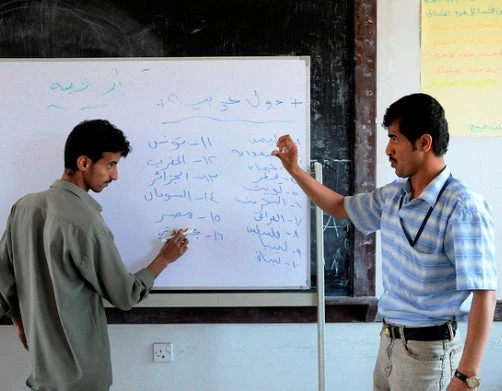
What stands out from the chart is the singular performance of the Middle East and North Africa (MENA) region which starts from within a cluster of low stock neighbors (namely South Asia and Sub-Saharan Africa) in the 1970s and then accelerates to converge with East Asia by 2010. At the same time, the gap with Latin America narrows rapidly. MENA is the only region with such a distinctive accelerating path.

Education attainment in the region rose from an average level of 2.3 years in 1970 to 7.5 years by 2010. This was by far the greatest percentage increase (215%) among all developing country regions, the next highest being Sub-Saharan Africa (with 180%).
Behind this performance lie remarkable individual country achievements. For example, Yemen had the best performance in the world in terms of percentage increase in education as it went from 0.06 years of schooling in 1970 to 3.7 years in 2010. While Yemen’s rank is affected by the extremely low level at which it started, other countries which started with much better initial levels continued to add to their stock at impressive rates. For example, Egypt, Algeria and Iran rank 8 th, 11 th and 19 th in global performance (out of 145 countries) and contribute the most to MENA’s top rank among regions.
The pattern of change over time suggests that it was not driven by income growth. The MENA region has gone through periods of high and low income growth over the past forty years, due in part to fluctuations in the price of oil, the region’s most important resource. However, the growth in education stock has been steady, year in and year out, suggesting a regional commitment to education as an end in itself.
In part, this regional commitment was manifested in the budget priority given to public spending on education. During the past forty years, MENA has spent around 16.5% of its budget on average on education. This is much higher than average budget shares for education in other regions, such as East Asia (with 14.7%) and Latin America (with 13.6%). Such education-orientation among MENA governments is undoubtedly one of the main reasons for its top-ranked performance in education attainment.
Another factor may have been the regional practice of subsidizing staple food items for all. While costly and inefficient, this does ensure a basic level of food sufficiency and nutrition especially among low income households. Better fed children are less likely to drop out of school at early ages due to health problems thereby contributing to education attainment. How does MENA compare in nutrition? The World Development Indicator database contains a measure called prevalence of undernourishment. MENA turns out to have the lowest level of undernourishment among developing country regions (8% on average since 1992, the earliest date for comparable international data on this measure). This must have been a source of advantage for it in relation to the challenge of increasing educational attainment over time. However, a disturbing trend is also at work. While still better than other developing regions, MENA has experienced deterioration in its absolute nutritional status in the last two decades. Whether this will slow, or indeed undermine, the steady growth in the region’s education stock is a subject for future research.


Join the Conversation